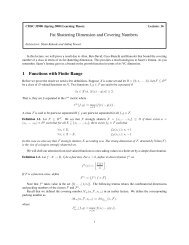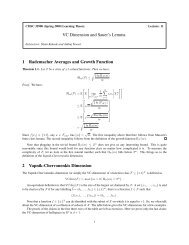Relax and Randomize: From Value to Algorithms
Relax and Randomize: From Value to Algorithms
Relax and Randomize: From Value to Algorithms
You also want an ePaper? Increase the reach of your titles
YUMPU automatically turns print PDFs into web optimized ePapers that Google loves.
[14] for the proof). We arrive at the upper bound<br />
1<br />
λ log ⎛ ⎝ ∑ f∈F<br />
exp (−λL t (f)) × exp (2λ 2<br />
max<br />
ɛ 1,...ɛ T −t ∈{±1}<br />
≤ 1 λ log ⎛ ⎝ ∑ exp (−λL t (f) + 2λ 2 T −t<br />
max<br />
f∈F<br />
ɛ 1,...ɛ T −t ∈{±1}<br />
≤ 1 λ log ⎛ ⎝ ∑ f∈F<br />
exp (−λL t (f)) ⎞ ⎠<br />
+ 2λ sup<br />
x<br />
sup<br />
∑<br />
i=1<br />
max<br />
f∈F ɛ 1,...ɛ T −t ∈{±1}<br />
T −t<br />
∑ l(f, x i (ɛ)) 2 ) ⎞<br />
i=1<br />
⎠<br />
l(f, x i (ɛ)) 2 ) ⎞ ⎠<br />
T −t<br />
∑ l(f, x i (ɛ)) 2<br />
i=1<br />
The last term, representing the “worst future”, is upper bounded by 2λ(T − t), assuming that the<br />
losses are bounded by 1. This removes the x tree <strong>and</strong> leads <strong>to</strong> the relaxation (9) <strong>and</strong> a computationally<br />
tractable algorithm.<br />
Proof of Proposition 4. The argument can be seen as a generalization of the Euclidean proof in [2]<br />
<strong>to</strong> general smooth norms. Let ˜x t−1 = ∑ t−1<br />
i=1 x i . The optimal algorithm for the relaxation (10) is<br />
√<br />
∥˜x t−1 ∥ 2 + ⟨∇ 1 2 ∥˜x t−1∥ 2 , x t ⟩ + C(T − t + 1)}} (27)<br />
f ∗ t<br />
Instead, let<br />
= argmin<br />
f∈F<br />
{ sup {⟨f, x t ⟩ +<br />
x t∈X<br />
f t = − √<br />
∇ 1 2 ∥˜x t−1∥ 2<br />
. (28)<br />
2 ∥˜x t−1 ∥ 2 + C(T − t + 1)<br />
Plugging this choice in<strong>to</strong> the admissibility condition (4), we get<br />
⎧⎪<br />
sup ⎨− ⟨∇ 1 2 ∥˜x t−1∥ 2 , x t ⟩<br />
x t∈X 2 √ A<br />
⎪⎩<br />
√<br />
+<br />
⎫⎪<br />
A + ⟨∇ 1 2 ∥˜x t−1∥ 2 , x t ⟩ ⎬<br />
⎪⎭<br />
where A = ∥˜x t−1 ∥ 2 + C(T − t + 1). It can be easily verified that an expression of the form −x/(2y) +<br />
√ y + x is maximized at x = 0 for a positive y. With these values,<br />
inf { sup {⟨f t , x t ⟩ + (∥˜x t−1 ∥ 2 + ⟨∇ 1 2 ∥˜x t−1∥ 2 , x t ⟩ + C(T − t + 1)) 1/2 }} = (∥˜x t−1 ∥ 2 + C(T − t + 1)) 1/2<br />
f t∈F x t∈X<br />
≤ (∥¯x t−2 ∥ 2 + ⟨∇ 1 2 ∥¯x t−2∥ 2 , x t−1 ⟩ + C(T − t + 2)) 1/2 = Rel T (F∣x 1 , . . . , x t−1 )<br />
Hence, the choice (28) is an admissible algorithm for the relaxation (10).<br />
Evidently, the above proof of admissibility is very simple, but it might seem that we pulled the<br />
algorithm (28) out of a hat. We now show that in fact one can derive this algorithm as a solution f ∗ t<br />
in (27). The proof below is not required for admissibility, <strong>and</strong> we only include it for completeness.<br />
The proof uses the fact that for any norm ∥ ⋅ ∥,<br />
⟨∇ 1 2 ∥x∥2 , x⟩ = ∥x∥ 2 . (29)<br />
To prove this, observe that by convexity ∥0∥ ≥ ∥x∥ + ⟨∇∥x∥, 0 − x⟩ <strong>and</strong> ∥2x∥ ≥ ∥x∥ + ⟨∇∥x∥, 2x − x⟩<br />
implying ⟨∇∥x∥, x⟩ = ∥x∥. On the other h<strong>and</strong>, by the chain rule, ∇ 1 2 ∥x∥2 = ∥x∥⋅∇∥x∥, thus implying<br />
(29).<br />
Let<br />
K ≜ Kernel(∇∥˜x t−1 ∥ 2 ) = {h ∶ ⟨∇ ∥˜x t−1 ∥ 2 , h⟩ = 0} , K ′ ≜ Kernel(˜x t−1 ) = {h ∶ ⟨h, ˜x t−1 ⟩ = 0} .<br />
We first claim that x t can always be written as x t = β˜x t−1 + γy for some y ∈ K <strong>and</strong> for some scalars<br />
β, γ. Indeed, suppose that x t = β˜x t−1 + γy + z for some y ∈ K <strong>and</strong> z ∉ K. Then we can rewrite x t as<br />
x t = (β + δ) ˜x t−1 + (γy − δ˜x t−1 + z)<br />
12




